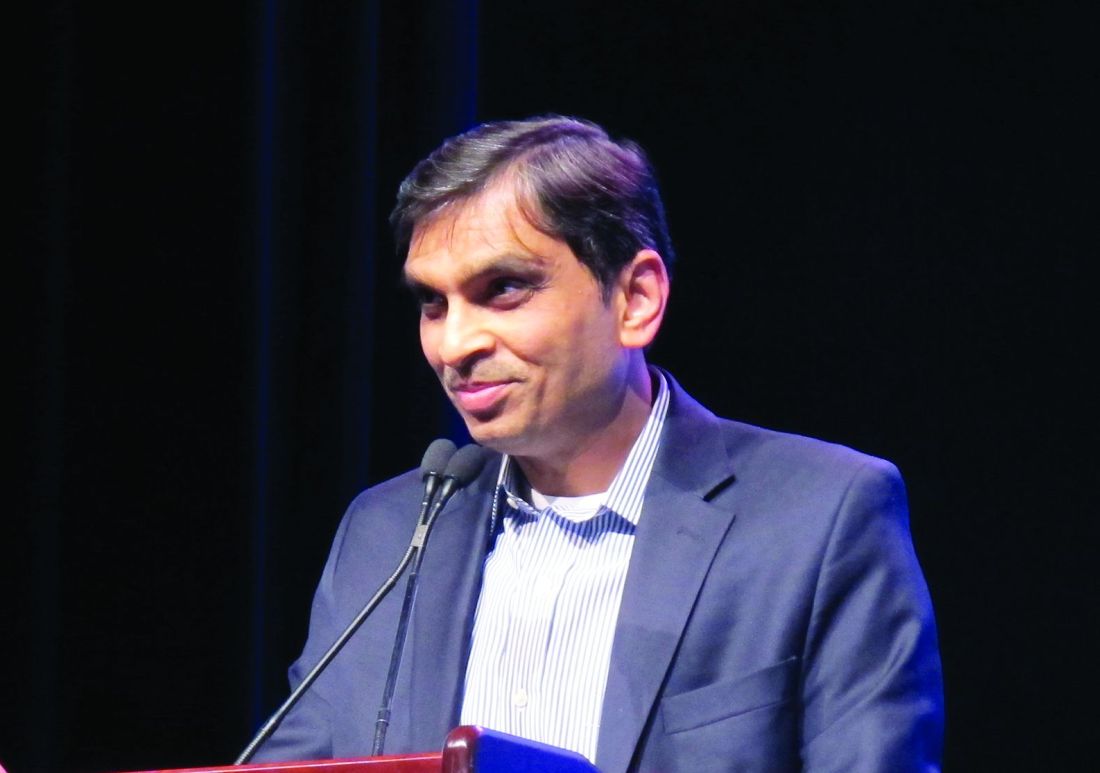User login
HOUSTON – Secondary acute myeloid leukemia (sAML) predicts outcomes after stem cell transplantation in first complete remission, whereas factors such as age, cytogenetics, and performance status are more relevant predictors of outcomes in patients with de novo AML, according to a large, registry-based analysis.
Of 11,439 patients with de novo AML and 1,325 with sAML identified in the registry, 7,691 and 909, respectively, underwent a stem cell transplant (SCT) in first complete remission (CR1), Bipin Savani, MD, said at the Transplantation & Cellular Therapies Meetings.
The 3-year cumulative incidence of relapse (CIR) and nonrelapse mortality (NRM) rates in those who underwent SCT in CR1 were higher in the sAML versus de novo AML groups (35% vs. 28.5% for CIR and 23.4% vs. 16.4% for NRM, respectively), said Dr. Savani, professor of medicine, director of the Long-Term Transplant Clinic, and medical director of the Stem Cell Transplant Processing Laboratory at Vanderbilt University Medical Center & Veterans Affairs Medical Center, Nashville, Tenn.
The 3-year overall survival (OS), leukemia-free survival (LFS), and graft-versus-host disease/relapse-free survival (GRFS) were significantly lower in the sAML group versus the de novo AML group (46.7% vs. 60.8% for OS; 41.6% vs. 55.1% for LFS; and 28.4% vs. 28.6% for GRFS).
Multivariate analysis controlling for risk factors and stratified by disease stage at SCT showed that sAML in CR1 was significantly associated with higher NRM (hazard ratio, 1.32) and CIR (HR, 1.28), and with lower LFS (HR, 1.30), OS (HR, 1.32) and GRFS (HR, 1.20).
Other significant predictors of OS in the model were age, cytogenetics, patient/donor sex combination, Karnofsky performance status (KPS), and donor, he said at the meeting held by the American Society for Blood and Marrow Transplantation and the Center for International Blood and Marrow Transplant Research. At its meeting, the American Society for Blood and Marrow Transplantation announced a new name for the society: American Society for Transplantation and Cellular Therapy (ASTCT).
In the patients who underwent SCT for primary refractory AML (607 with de novo AML and 199 with sAML) or relapsed AML (1,009 with de novo AML and 124 with sAML), the outcomes were generally inferior to those seen with SCT in CR1. However, sAML in those patients did not predict outcomes, Dr. Savani said, noting that outcome in those cases were predicted by age, cytogenetics, and KPS.
In an analysis of 877 pairs matched for age, disease stage at SCT, KPS, conditioning, in vivo/ex vivo T-cell depletion, donor, donor/recipient sex and cytomegalovirus-status combination, cytogenetics, and graft source, the finding that sAML was associated with significantly higher NRM, and lower LFS, OS, and GRFS overall was confirmed.
However, stratification by stage at the time of SCT again showed that the differences between groups were only seen among those transplanted in CR1, and not in those with advanced disease at the time of transplant.
Patients included in the study were adults aged 18 years and older who underwent SCT for de novo or sAML from a matched related, unrelated, or T-cell replete haploidentical donor between 2000 and 2016.
The findings confirm the general belief that the prognosis in AML secondary to another hematologic neoplasia or malignant disease is poorer than that for de novo AML, and clarify the role of this difference for SCT, Dr. Savani said.
“These data may help to improve risk stratification and prognostic estimates after allogeneic hematopoietic cell transplantation for acute myeloid leukemia,” he concluded.
Dr. Savani reported having no financial disclosures.
SOURCE: Savani B et al. TCT 2019, Abstract 12.
HOUSTON – Secondary acute myeloid leukemia (sAML) predicts outcomes after stem cell transplantation in first complete remission, whereas factors such as age, cytogenetics, and performance status are more relevant predictors of outcomes in patients with de novo AML, according to a large, registry-based analysis.
Of 11,439 patients with de novo AML and 1,325 with sAML identified in the registry, 7,691 and 909, respectively, underwent a stem cell transplant (SCT) in first complete remission (CR1), Bipin Savani, MD, said at the Transplantation & Cellular Therapies Meetings.
The 3-year cumulative incidence of relapse (CIR) and nonrelapse mortality (NRM) rates in those who underwent SCT in CR1 were higher in the sAML versus de novo AML groups (35% vs. 28.5% for CIR and 23.4% vs. 16.4% for NRM, respectively), said Dr. Savani, professor of medicine, director of the Long-Term Transplant Clinic, and medical director of the Stem Cell Transplant Processing Laboratory at Vanderbilt University Medical Center & Veterans Affairs Medical Center, Nashville, Tenn.
The 3-year overall survival (OS), leukemia-free survival (LFS), and graft-versus-host disease/relapse-free survival (GRFS) were significantly lower in the sAML group versus the de novo AML group (46.7% vs. 60.8% for OS; 41.6% vs. 55.1% for LFS; and 28.4% vs. 28.6% for GRFS).
Multivariate analysis controlling for risk factors and stratified by disease stage at SCT showed that sAML in CR1 was significantly associated with higher NRM (hazard ratio, 1.32) and CIR (HR, 1.28), and with lower LFS (HR, 1.30), OS (HR, 1.32) and GRFS (HR, 1.20).
Other significant predictors of OS in the model were age, cytogenetics, patient/donor sex combination, Karnofsky performance status (KPS), and donor, he said at the meeting held by the American Society for Blood and Marrow Transplantation and the Center for International Blood and Marrow Transplant Research. At its meeting, the American Society for Blood and Marrow Transplantation announced a new name for the society: American Society for Transplantation and Cellular Therapy (ASTCT).
In the patients who underwent SCT for primary refractory AML (607 with de novo AML and 199 with sAML) or relapsed AML (1,009 with de novo AML and 124 with sAML), the outcomes were generally inferior to those seen with SCT in CR1. However, sAML in those patients did not predict outcomes, Dr. Savani said, noting that outcome in those cases were predicted by age, cytogenetics, and KPS.
In an analysis of 877 pairs matched for age, disease stage at SCT, KPS, conditioning, in vivo/ex vivo T-cell depletion, donor, donor/recipient sex and cytomegalovirus-status combination, cytogenetics, and graft source, the finding that sAML was associated with significantly higher NRM, and lower LFS, OS, and GRFS overall was confirmed.
However, stratification by stage at the time of SCT again showed that the differences between groups were only seen among those transplanted in CR1, and not in those with advanced disease at the time of transplant.
Patients included in the study were adults aged 18 years and older who underwent SCT for de novo or sAML from a matched related, unrelated, or T-cell replete haploidentical donor between 2000 and 2016.
The findings confirm the general belief that the prognosis in AML secondary to another hematologic neoplasia or malignant disease is poorer than that for de novo AML, and clarify the role of this difference for SCT, Dr. Savani said.
“These data may help to improve risk stratification and prognostic estimates after allogeneic hematopoietic cell transplantation for acute myeloid leukemia,” he concluded.
Dr. Savani reported having no financial disclosures.
SOURCE: Savani B et al. TCT 2019, Abstract 12.
HOUSTON – Secondary acute myeloid leukemia (sAML) predicts outcomes after stem cell transplantation in first complete remission, whereas factors such as age, cytogenetics, and performance status are more relevant predictors of outcomes in patients with de novo AML, according to a large, registry-based analysis.
Of 11,439 patients with de novo AML and 1,325 with sAML identified in the registry, 7,691 and 909, respectively, underwent a stem cell transplant (SCT) in first complete remission (CR1), Bipin Savani, MD, said at the Transplantation & Cellular Therapies Meetings.
The 3-year cumulative incidence of relapse (CIR) and nonrelapse mortality (NRM) rates in those who underwent SCT in CR1 were higher in the sAML versus de novo AML groups (35% vs. 28.5% for CIR and 23.4% vs. 16.4% for NRM, respectively), said Dr. Savani, professor of medicine, director of the Long-Term Transplant Clinic, and medical director of the Stem Cell Transplant Processing Laboratory at Vanderbilt University Medical Center & Veterans Affairs Medical Center, Nashville, Tenn.
The 3-year overall survival (OS), leukemia-free survival (LFS), and graft-versus-host disease/relapse-free survival (GRFS) were significantly lower in the sAML group versus the de novo AML group (46.7% vs. 60.8% for OS; 41.6% vs. 55.1% for LFS; and 28.4% vs. 28.6% for GRFS).
Multivariate analysis controlling for risk factors and stratified by disease stage at SCT showed that sAML in CR1 was significantly associated with higher NRM (hazard ratio, 1.32) and CIR (HR, 1.28), and with lower LFS (HR, 1.30), OS (HR, 1.32) and GRFS (HR, 1.20).
Other significant predictors of OS in the model were age, cytogenetics, patient/donor sex combination, Karnofsky performance status (KPS), and donor, he said at the meeting held by the American Society for Blood and Marrow Transplantation and the Center for International Blood and Marrow Transplant Research. At its meeting, the American Society for Blood and Marrow Transplantation announced a new name for the society: American Society for Transplantation and Cellular Therapy (ASTCT).
In the patients who underwent SCT for primary refractory AML (607 with de novo AML and 199 with sAML) or relapsed AML (1,009 with de novo AML and 124 with sAML), the outcomes were generally inferior to those seen with SCT in CR1. However, sAML in those patients did not predict outcomes, Dr. Savani said, noting that outcome in those cases were predicted by age, cytogenetics, and KPS.
In an analysis of 877 pairs matched for age, disease stage at SCT, KPS, conditioning, in vivo/ex vivo T-cell depletion, donor, donor/recipient sex and cytomegalovirus-status combination, cytogenetics, and graft source, the finding that sAML was associated with significantly higher NRM, and lower LFS, OS, and GRFS overall was confirmed.
However, stratification by stage at the time of SCT again showed that the differences between groups were only seen among those transplanted in CR1, and not in those with advanced disease at the time of transplant.
Patients included in the study were adults aged 18 years and older who underwent SCT for de novo or sAML from a matched related, unrelated, or T-cell replete haploidentical donor between 2000 and 2016.
The findings confirm the general belief that the prognosis in AML secondary to another hematologic neoplasia or malignant disease is poorer than that for de novo AML, and clarify the role of this difference for SCT, Dr. Savani said.
“These data may help to improve risk stratification and prognostic estimates after allogeneic hematopoietic cell transplantation for acute myeloid leukemia,” he concluded.
Dr. Savani reported having no financial disclosures.
SOURCE: Savani B et al. TCT 2019, Abstract 12.
REPORTING FROM TCT 2019

